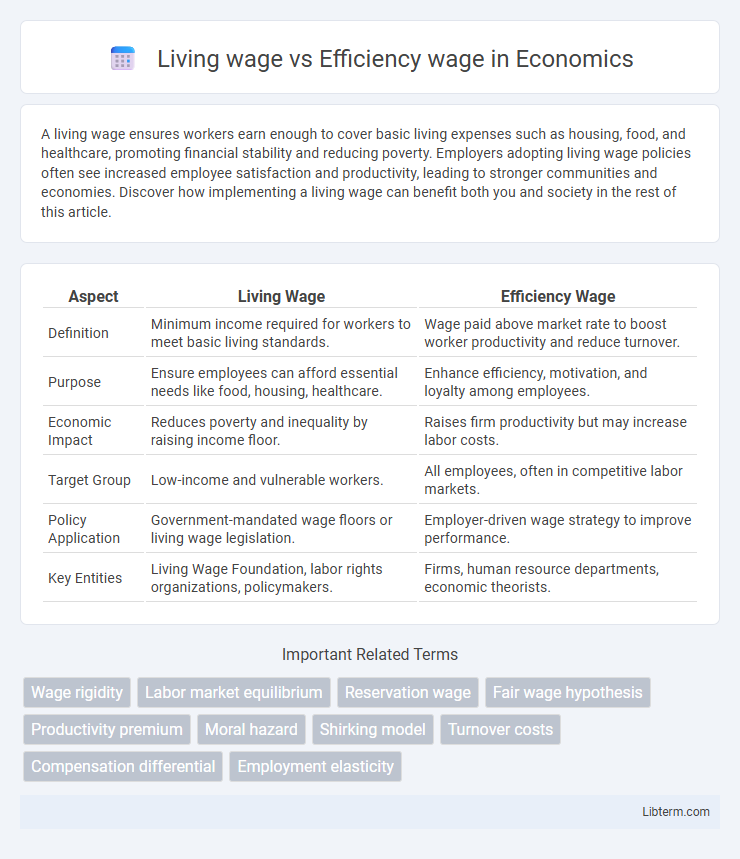A living wage ensures workers earn enough to cover basic living expenses such as housing, food, and healthcare, promoting financial stability and reducing poverty. Employers adopting living wage policies often see increased employee satisfaction and productivity, leading to stronger communities and economies. Discover how implementing a living wage can benefit both you and society in the rest of this article.
Table of Comparison
| Aspect | Living Wage | Efficiency Wage |
|---|---|---|
| Definition | Minimum income required for workers to meet basic living standards. | Wage paid above market rate to boost worker productivity and reduce turnover. |
| Purpose | Ensure employees can afford essential needs like food, housing, healthcare. | Enhance efficiency, motivation, and loyalty among employees. |
| Economic Impact | Reduces poverty and inequality by raising income floor. | Raises firm productivity but may increase labor costs. |
| Target Group | Low-income and vulnerable workers. | All employees, often in competitive labor markets. |
| Policy Application | Government-mandated wage floors or living wage legislation. | Employer-driven wage strategy to improve performance. |
| Key Entities | Living Wage Foundation, labor rights organizations, policymakers. | Firms, human resource departments, economic theorists. |
Introduction to Living Wage and Efficiency Wage
Living wage refers to the minimum income necessary for a worker to meet basic needs such as housing, food, and healthcare, ensuring a decent standard of living. Efficiency wage theory suggests that employers pay wages above the market equilibrium to increase worker productivity, reduce turnover, and attract higher-quality employees. Both concepts address wage setting but differ in focus: living wage emphasizes social equity, while efficiency wage centers on improving organizational performance.
Defining Living Wage: Purpose and Principles
A living wage is defined as the minimum income necessary for a worker to meet basic needs such as food, housing, healthcare, and education, ensuring a decent quality of life. Its purpose is to promote social equity and economic sustainability by enabling employees to cover essential expenses without relying on government assistance. Principles guiding a living wage include fairness, adequacy, and the consideration of local cost-of-living variations to reflect real economic conditions.
Understanding the Efficiency Wage Theory
Efficiency Wage Theory posits that paying employees wages above the market equilibrium can increase productivity and reduce turnover by boosting worker morale and incentivizing effort. This theory contrasts with the living wage concept, which emphasizes ensuring a minimum income to meet basic living standards without necessarily targeting productivity gains. Firms adopting efficiency wages aim to enhance overall efficiency, resulting in cost savings that can offset higher wage expenses.
Key Differences Between Living Wage and Efficiency Wage
Living wage represents the minimum income necessary for workers to meet basic living standards, ensuring financial security and well-being. Efficiency wage is a salary set above the market equilibrium to boost worker productivity, reduce turnover, and attract high-quality employees. Key differences include living wage's focus on subsistence and fairness, while efficiency wage targets enhanced organizational performance and economic incentives.
Economic Impacts of Living Wage Policies
Living wage policies raise the minimum income to meet basic living costs, potentially increasing consumer purchasing power and stimulating local economies. This boost in demand can lead to job creation, although some businesses may reduce hiring or increase prices to offset higher labor costs. Research shows balanced living wage implementations can reduce poverty rates and improve worker productivity without causing significant unemployment.
Business Outcomes of Implementing Efficiency Wages
Implementing efficiency wages enhances employee productivity by incentivizing higher effort and reducing turnover, which lowers recruitment and training costs. Businesses benefit from improved work quality and increased motivation, leading to higher profitability and competitive advantage. Efficiency wages also foster loyalty and minimize shirking, thereby optimizing operational efficiency and sustaining long-term organizational performance.
Social Equity and Wage Structures
Living wage policies prioritize social equity by ensuring workers earn enough to meet basic living standards, reducing poverty and income inequality. Efficiency wage theories advocate higher-than-market wages to boost productivity and reduce turnover, indirectly influencing wage structures by promoting fair compensation tied to performance. Both approaches reshape labor markets but differ in their emphasis on equity versus incentivizing efficiency within wage systems.
Employee Productivity and Retention Effects
Living wage policies enhance employee productivity by improving workers' financial stability, leading to increased motivation and reduced absenteeism. Efficiency wage theory suggests paying above-market wages boosts productivity by attracting higher-quality applicants and deterring shirking, resulting in better retention and lower turnover costs. Both wage strategies contribute to stronger employee commitment and sustained organizational performance through improved morale and loyalty.
Challenges in Adopting Wage Strategies
Adopting living wage strategies often faces challenges such as increased labor costs leading to potential price inflation and reduced competitiveness in global markets. Efficiency wage approaches encounter difficulties in accurately measuring productivity gains and may create wage disparities that affect employee morale. Both wage strategies require careful balancing to maintain profitability while ensuring fair compensation and workforce motivation.
Future Trends and Policy Implications
Future trends in wage policies emphasize the growing relevance of living wages as a benchmark for fair pay, reflecting rising costs of living and growing income inequality worldwide. Efficiency wage theory continues to influence employer strategies, suggesting that higher pay can boost productivity, reduce turnover, and enhance worker motivation. Policymakers are increasingly balancing these approaches, considering reforms that promote living wages to improve social welfare while leveraging efficiency wage principles to sustain economic competitiveness.
Living wage Infographic

 libterm.com
libterm.com